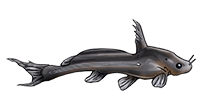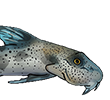Article © Mark Walters, uploaded February 06, 2025.
/1.jpg) Scleromystax sp. C113 - mature male and female (below)
Scleromystax sp. C113 - mature male and female (below)
When Pier Aquatics in Wigan, UK announced an import of Baianinho III catfish from South-East Brazil, I wasted no time in visiting the store to pick up three adults. That was back in the autumn of 2006 and greeting me was a collection of one of the most stunning new types of Corydoradinae seen in recent years. There was no clear differentiation between sexes in that shipment, so I selected two with the greatest difference in body shape and finnage and one of intermediate proportions. They ranged between 5-6.5cm/2-2.5" and all had flowing pectoral fins and a stunning gold/green flash down the back.
They were housed in a typical Corydoradinae type set-up, a 136/30-gal tank with sponge filtration, a sand substrate, bogwood and Java moss maintained at 24°C/75°F. A long snout and constant foraging in the sand indicated their preferred food and worms of all types were eagerly devoured.
Even now, I continue to be amazed by their non-stop activity as they cruise the mid-waters, chasing and sparring with their conspecifics. This activity is a refreshing change from other types of Corydoradinae I have kept! Baianinho III is a member of the catfish genus Scleromystax, which was split from Corydoras in 2003. The genus includes frequently encountered species like S. barbatus and S. lacerdai, and the then protected S. macropterus. Although not officially recognized, Baianinho III has been given the 'C' number 113. This is akin to the 'L' numbering system devised for naming unidentified Loricariid species but is used to give identities to new Corydoradinae.
/11.jpg) Scleromystax sp. C113 - Eggs
Scleromystax sp. C113 - Eggs
C113 has been given to another Scleromystax similar to S. lacerdai. After researching, I realized that the conditions I was offering were probably on the cool side as C113 comes from the eastern corner of Brazil, in the state of Bahia. Another catfish that comes from this region is the Bearded catfish, Scleromystax barbatus, which enjoys cooler temperatures and swims in the Atlantic coastal streams. Conditions suitable for S. barbatus, which I have bred for several years, should be suitable for C113.
I moved the group to a tank on the bottom tier of the fish house at around 20°C/68°F and this time used a Fluval 4 internal filter. This is total over-filtration for a 68/15-gal tank, but they seemed to enjoy the current. Despite the cooler water and daily feeding with chopped earthworms, frozen bloodworm, and live Daphnia, there was no real indication of breeding activity or a clear differentiation between the fish. Discussions with Corydoradinae expert Ian Fuller, who had also picked up a group, suggested that the autumn shipment of 2006 could have been an all-male affair.
Interest in this catfish had spread among other Corydoras enthusiasts and Pier Aquatics duly obliged with a second shipment of C113s in the spring of 2007. This time there was no mistaking females among the group, with much-reduced pectoral fins and a wider girth when viewed from above. I selected a pair and added these to my group. The interest from my original males was obvious and the usual hyperactivity became even more frenetic.
Over the coming weeks, I offered my group the best live food in the fish house, performed weekly 50% water changes, maintaining soft water at a pH around 6 (using 50/50 rainwater and treated tap water), and watched and waited. Nothing happened for two months, and I began to wonder if the female was, in fact, another male. I fished the group out for a closer inspection and was left in no doubt that I had four males and a female.
/12.jpg) Scleromystax sp. C113 - 18 day old fry
Scleromystax sp. C113 - 18 day old fry
The differences are quite apparent in adults. The male pectoral fins sweep down the sides of the body, almost reaching the anal fin. In addition, the most intensely coloured male displayed cheek bristles - a diagnostic feature of Scleromystax catfish. The female has standard, more-rounded pectoral fins and a fuller profile. I took a few photographs, popped them back in the tank and a few days later was amazed to see a patch of eggs stuck to the glass. Prior to that first spawning, I had added a few litres of water from an adjacent tank where S. barbatus were in the full throes of spawning. I hoped the pheromone-laden water might do something to encourage the C113s, but only they will know what stimulated them!
Although I didn't witness the first event, subsequent spawns have been preceded by the female performing dry runs, looking for suitable spawning sites and driving the males wild. The actual act of courtship involves the female selecting a suitable male - usually the dominant fish - and embracing him for a few seconds in the classic 'T' position. The female then deposits five to eight eggs in her pelvic fins and places them on the chosen substrate. In all spawns, the eggs have been laid against the glass in an area of strong current. That first time, 69 eggs were laid in neat rows, so unlike the random clustering of S. barbatus.
/13.jpg) Scleromystax sp. C113 - Six week old juveniles
Scleromystax sp. C113 - Six week old juveniles
I removed the eggs after 12 hours, giving enough time for each membrane to toughen. Baianinho III eggs are highly adhesive, as expected under the flow conditions. But, rather than using a razor blade, I prefer to roll or peel Corydoradinae eggs from the glass with my fingers. This seems to minimize the risk of egg damage. Another tip is to re-adhere the eggs on the side of the hatching tub, if possible, rather than dropping them to the bottom of the container. For hatching, I usually use a one or two-litre clear Perspex tub with reasonable aeration and a few alder cones to reduce fungus.
The eggs hatched after four days, and I was presented with 60-odd wriggling blobs. After another four days, they were offered microworm and ZM100 fry-food in alternate feeds, twice daily - and 90% of the water was changed twice daily, using the parent tank water. Growth was quite rapid and, after two weeks, the youngsters were starting to show the first signs of pigmentation. I transferred the fry to a 30cm/12" rearing tank with a sponge filter and increased the range of foods offered. By four weeks, the youngsters were even tackling whiteworm and Daphnia. After eight weeks the fry measured 2cm/0.8" standard length.
The parent fish have since spawned five times, at fortnightly intervals. Spawns have averaged 60-80 eggs, with a very high hatching and survival rate. C113 has everything going for it, being an attractive and active catfish without the aggression between males sometimes experienced with its close relative S. barbatus. I hope to distribute my offspring among enthusiasts and fellow Catfish Study Group members and look forward to Baianinho III remaining in the hobby for years to come.
There is further information on this species on the Cat-eLog page.
Back to Shane's World index.




